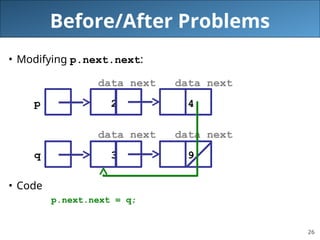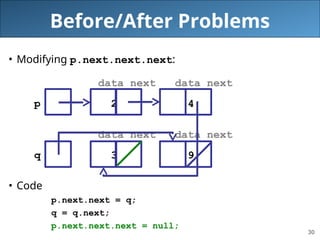Doubly Circular Linked List – Both next and previous pointers form a circular connection.
- 1. CSE 143 Lecture 6 Linked Lists slides created by Ethan Apter http://www.cs.washington.edu/143/
- 2. 2 Array-Based List Review • Array-based lists are what we’ve studied so far – ArrayIntList, ArrayList, SortedIntList all use arrays • Arrays use a contiguous block of memory • This means all elements are adjacent to each other 0 1 2 3 4 5 6 7 8 6 2 5 3 7 1 4 -9 -8
- 3. 3 Advantages and Disadvantages • Advantages of array-based lists – random access: can get any element in the entire array quickly • kind of like jumping to any scene on a DVD (no fast-forwarding required) • Disadvantages of array-based lists – can’t insert/remove elements at the front/middle easily • have to shift the other elements – can’t resize array easily • have to create a new, bigger array
- 4. 4 Linked Lists • A linked list is a type of list • But instead of a contiguous block of memory, like this: 0 1 2 3 4 5 6 7 8 9 • Linked list elements are scattered throughout memory: 8 9 7 5 6 • But now the elements are unordered. How do linked lists keep track of everything?
- 5. 5 Linked Lists • Each element must have a reference to the next element: 8 9 7 5 6 • Now, so long as we keep track of the first element (the front), we can keep track of all the elements front back
- 6. 6 Linked Lists • These references to the next element mean that linked lists have sequential access • This means that to get to elements in the middle of the list, we must first start at the front and follow all the links until we get to the middle: – kind of like fast-forwarding on a VHS tape – so getting elements from the middle/back is slow • Linked lists also do some things well: – linked lists can insert elements quickly (no “shifting” needed) – linked lists can always add more elements (no set capacity) • So there are tradeoffs between array lists and linked lists
- 7. 7 List Nodes • List node: an element in a linked list – an individual list nodes is very simple, but multiple list nodes can be used to build complex structures • Each list node contains: – a piece of data – a reference to the next list node • We typically draw list nodes like this: data next 18
- 8. 8 ListNode • Code for a simple ListNode class containing ints as data: public class ListNode { public int data; public ListNode next; } • ListNode is poorly encapsulated (it has public fields) – but that’s ok for now. We’ll talk about it more, later.
- 9. 9 ListNode • ListNode is a recursive data structure • This means a ListNode is defined in terms of itself • A ListNode contains: – data – a reference to a ListNode • A ListNode does not contain another ListNode – Instead, it contains a reference to another ListNode
- 10. 10 Building a Small Linked List • Let’s make a short linked list containing 3, 7, and 12 • First, we need a reference to the front of the linked list: ListNode front; • The variable front is not a ListNode – it is just a variable that can refer to a ListNode • We will draw front like this: front ? We’ll replace the ? with an actual ListNode soon
- 11. 11 Building a Small Linked List • To make an actual ListNode, we must call new: front = new ListNode(); • This constructs a new node and makes front refer to it: data next front 0 null • Notice that Java automatically initialized data and next to their zero-equivalents – ints: 0 – objects: null (means “no object”)
- 12. 12 Building a Small Linked List • In this first node, we want to store a 3 and have it point to a new node. We can use dot notation for this: front.data = 3; front.next = new ListNode(); • And now our list looks like this: data next data next front 3 0 null front.data front.next
- 13. 13 Building a Small Linked List • In the second node, we want to store a 7 and have it point to a new node: front.next.data = 7; front.next.next = new ListNode(); • And now our list looks like this: data next data next data next front 3 7 0 null front.next.data front.next.next
- 14. 14 Building a Small Linked List • In the last node, we want to store a 12 and terminate our list: front.next.next.data = 12; front.next.next.next = null; • And now our completed list looks like this: data next data next data next front 3 7 12 null front.next.next.data front.next.next.next
- 15. 15 Building a Small Linked List • It wasn’t strictly necessary to set the last field to null • Java had already done it, since null is a zero-equivalent • But it’s ok to be explicit about this kind of thing • Also, we normally draw null as a diagonal line: data next data next data next front 3 7 12
- 16. 16 Improving ListNode • Let’s add some constructors to our ListNode class: public class ListNode { public int data; public ListNode next; public ListNode() { this(0, null); } public ListNode(int data) { this(data, null); } public ListNode(int data, ListNode next) { this.data = data; this.next = next; } } Notice we still have one “main” constructor that is called by the other two
- 17. 17 Better Linked List Code • Our new ListNode constructors allows us to build our list containing 3, 7, and 12 in just one line of code: ListNode front = new ListNode(3, new ListNode(7, new ListNode(12))); • This is a huge improvement – but it’s still tedious and error-prone • There is a better way! We can use loops on linked lists • ...but we won’t for a little longer – working with list nodes is challenging, so let’s get more practice
- 18. 18 Basic Linked List Questions • Suppose you have two variables of type ListNode named p and q. Consider the following situation: data next data next p 2 4 data next data next q 3 9 • How many variables of type ListNode are there? • How many ListNode objects are there?
- 19. 19 Basic Linked List Questions • How many variables of type ListNode are there? – 6, circled in green data next data next p 2 4 data next data next q 3 9
- 20. 20 Basic Linked List Questions • How many ListNode objects are there? – 4, circled in green data next data next p 2 4 data next data next q 3 9
- 21. 21 Before/After Problems • Consider the same situation as before: data next data next p 2 4 data next data next q 3 9 • How would you transform it to the following picture? data next data next data next p 2 4 3 data next q 9
- 22. 22 Before/After Problems • Which variables need to change in order to arrive at the solution? data next data next p 2 4 data next data next q 3 9
- 23. 23 Before/After Problems • Which variables/links need to change in order to arrive at the solution? – 3, colored green data next data next p 2 4 data next data next q 3 9
- 24. 24 Before/After Problems • But the order we change the links is also important • In the final situation, q should point to the ListNode containing the 9. But if we do that first: data next data next p 2 4 data next data next q 3 9 • ...we permanently lose the ListNode containing the 3
- 25. 25 Before/After Problems • So how do we actually solve it? data next data next p 2 4 data next data next q 3 9 Change this one first. It points to null, so we can’t lose anything by changing it
- 26. 26 Before/After Problems • Modifying p.next.next: data next data next p 2 4 data next data next q 3 9 • Code p.next.next = q;
- 27. 27 Before/After Problems • What’s next? data next data next p 2 4 data next data next q 3 9 The ListNode referred to by q is now saved, so we can now safely change what q refers to
- 28. 28 Before/After Problems • Modifying q: data next data next p 2 4 data next data next q 3 9 • Updated code p.next.next = q; q = q.next;
- 29. 29 Before/After Problems • What’s next? data next data next p 2 4 data next data next q 3 9 The ListNode containing the 3 should refer to null. It is now safe to change this link.
- 30. 30 Before/After Problems • Modifying p.next.next.next: data next data next p 2 4 data next data next q 3 9 • Code p.next.next = q; q = q.next; p.next.next.next = null;
- 31. 31 Before/After Problems • We’re all done (even though it looks weird) data next data next p 2 4 data next data next q 3 9 • Code p.next.next = q; q = q.next; p.next.next.next = null;
- 32. 32 Final Thoughts • Working with linked lists can be hard • So draw lots of pictures! • jGRASP’s debugger can also be helpful – but remember: you won’t have jGRASP on the exams – and linked lists are definitely on the exams • Sometimes, solving one of these problems requires a temporary variable: ListNode temp = p; This creates a ListNode variable. It does not create a new ListNode object (no































